by Friedrich Hansen (November 2017)
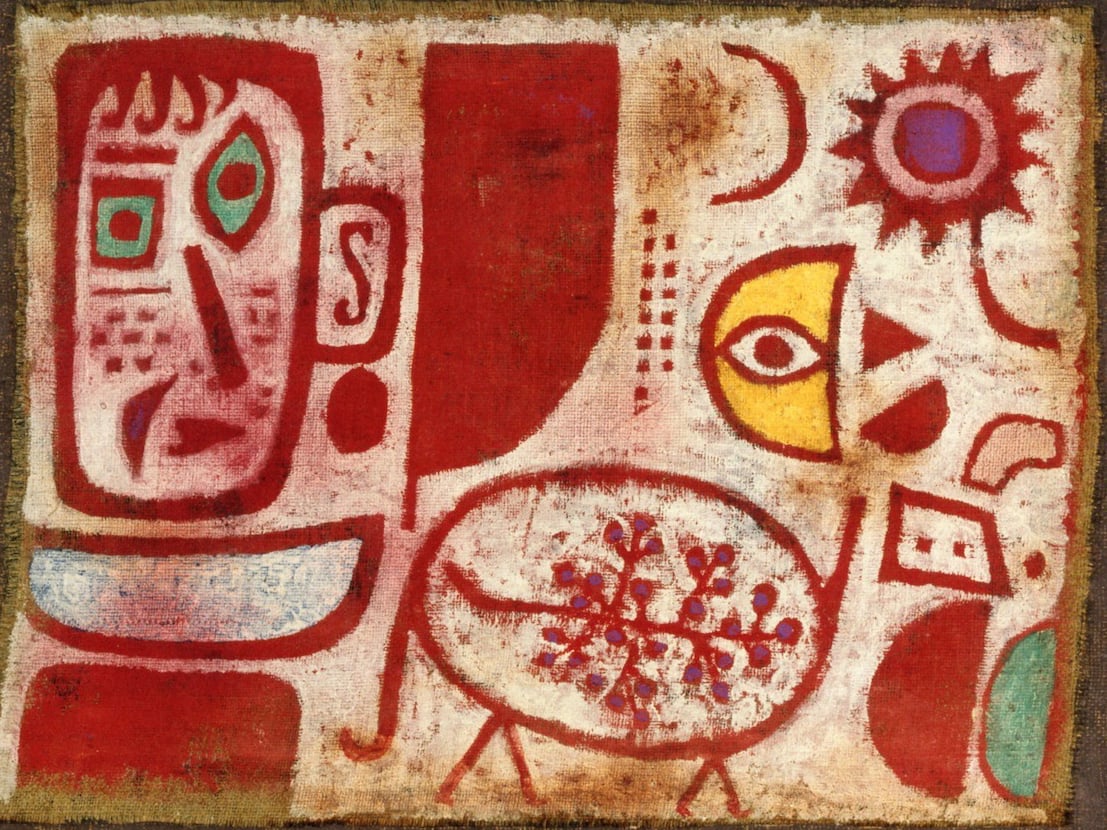
Frenzy/Raush or Intoxication, Paul Klee, 1939
The discrimination between sin and sinner is the mother of all separations and the premise for atonement. The inner moral dualism which allows the self to choose right over wrong depends on a switch of perspective in the human mind. It represents the cardinal accomplishment of guilt culture consisting of the monotheist algorithm for repentance which is instrumental for acknowledging our wrongs in order to overcome them. After all, atonement is an inescapable personal way for embracing a change for the better, earning us redemption. It is for this reason that a frank rejection of this venerable institution by sexual identity politcs represents a break up of Western civilization, the Judeo-Christian culture of moral struggle of the self, reflecting the tension between instinct and conscience. The notion of making the sin of sexual license into a virtue or identity is unsustainable.
It is true that the denouement of guilt has its roots in the violent shame-honor-and-revenge cultures that dominated Hellenistic antiquity. But it was Judaism that introduced the discrimination between sin and sinner, opening up the gates for sublimation, learning, and personal refinement.
Governments seem to have no idea what is at stake when they blithely exclude gender politics from the millennial demands for repentance in the West under the folly of anti-discrimination, pulling the carpet from under the principles of our constitutionalism. For gender identity politics draw on the anti-authoritarian construct of flat “vegetable man” who lives in denial of inner moral dualism, which also served us as the reservoir for conflict resolution. It is for this reason that we are seeing a surge of agonizing culture wars, the fading away of tolerance and the smothering of discourse on campuses by equally tyrannical (and as fragile) Millennnials. Paul Klee was one of the first thinkers to see this coming with his sujets such as fragmentation, separation, or the romantic rejection of limits, to which we will attend in a minute.
The Campus “vegetables” are prepared to enoble any new sexual drive to the status of victims, giving them moral immunity. This way they keep recruiting yet another cohort of their tyrannical rainbow coalition—people who simply reject out-of-hand any change of their personalities and catering only to blame and revenge. Their “organic” aestheticism is deeply anti-intellectual, romantic, and submissive to the state—suggestive of its Protestant extraction. Romantic “vegetables” used to immitate plants, beings who are stationary by nature and also remain identical for a lifetime. They feed on fictional reality and the rejection of any limits or borers: “We want everything, share it with everyone and want it now.”
Funny enough they can even claim Johann Wolfgang Goethe as their patron saint, a man who prided himself for being indignant at the romantics. In 1787, he famously discovered the “original plant” in Palermo while on his Italian journey. He had fled to Sicily in order to recover from a broken love affair in Weimar with one Lady von Stein, an aristocratic celebrity. His equally exculpatory and deterministic notion of an arch plant was unmistakenly copied from the Hellenistic concept of “original sin,” rejected by Judaism. Geothe designed his mundane copy—unconsciously as it were—as a panacea for guilt feelings. After all, he had abruptly abandoned his lover back in Germany without even saying “good bye.”
No doubt Goethe‘s metaphor of original plant is a classical metamphor for turning moral issues into aesthetic ones in order to achieve some expiation of his guilt. Not for nothing is “Original sin“ strongly associated with the “fall of man,” a general clause offering elegant liberal escapes from comitted sin by burying the silent particular under the noisy univerals—a liberal favorite intellectual operation known as abstraction. Goethe even pretended to deliver scienctific innovation with his work of “sublimation in progress” eventually arriving at his “original plant.” As a benefit of his sober evolutionary time lapse, or visual displacement, he was to gain expiation for a moral lapse—an act that, for Freud, would qualify as rationalization. As a cover for his self-betrayal, Goethe would go on to berate romanticism for the rest of his life. This life-lie is one of the reasons why Goethe, as E.M. Butler observed, did not reach his full creative potential. He became as victim of the deceptive “innocence” of the vegetable stereotype. It was the romantics who went on to make the “transition” regarding innocence from Goethe‘s Original plant as carapace to that of modern liberal victimology. Nevertheless, Goethe’s genius created a pseudo-scientific theology for true sacrifical vegan atonement drawing on Christian passion for his own metamorphosis. In the end he managed to rid himself of his bad conscience or the “inner perspective” for good—objectifying guilt in his Faust drama.
It was famously Nietzsche who re-discovered the “change of perspective” under the romantic carapace of original plant—Goethe’s determinist vegetable paradigm fo guilt. Nietzsche (and later Freud) continued where Goethe had left off; the result being the reduction of Christian inner dualism into affirmative psychology—the bane of modernity. It is a well established conviction that Friedrich Nietzsche “played out psychology against philology” (Hans Mayer: “Außenseiter” 1977) or what is today known as classic epistemology. That’s why it is important today to recover biblical epistemology and for this endeavour, Paul Klee turns out to be a lively inspiration. The context for this is the decline of cultural Protestantism, concluded in the demise of Swiss banking as we knew it. The philosophic part of the exhibition, “Dichter und Denker,” is open until November 26, while the epigonal show “10 Americans After Paul Klee,” which includes many of Klee’s signature works, is open until January 7, 2018.
Christ filling the Visual Gap
Jean Paul Sartre’s voyeur, the secret observer from behind, became the sublime subject of his existentialist philosophy. It depended utterly on the category of voyeurism understood as a mute variety of Christ’s incarnation or complementary visual existence. The voyeurist is a truely congenial figure to the Nazarene being designed, as it were, to fill the existentially human “visual gap,” the blind spot of human vision in our rear. Existentialism is about little more than that, a philosophy and French equivalent of the much older English “Peeping Tom” that also exploited the human visual handicap. In Weimar the “visual gap” gained demagogic currency after the Treaty of Versaille in the political arena with eerie “back stabbing,” often blaming minorities as traitors of the German cause as a “fifth column.” This reached into the deepest recesses of the Germanic identity with the Nibelung hero Siegfried’s, strangely enough most vulnerable at his back between the shoulder blades while Achilles depended on his tendon. The Nibelungs were obviously even more deeply invested in the visual paradigm than the Greeks.
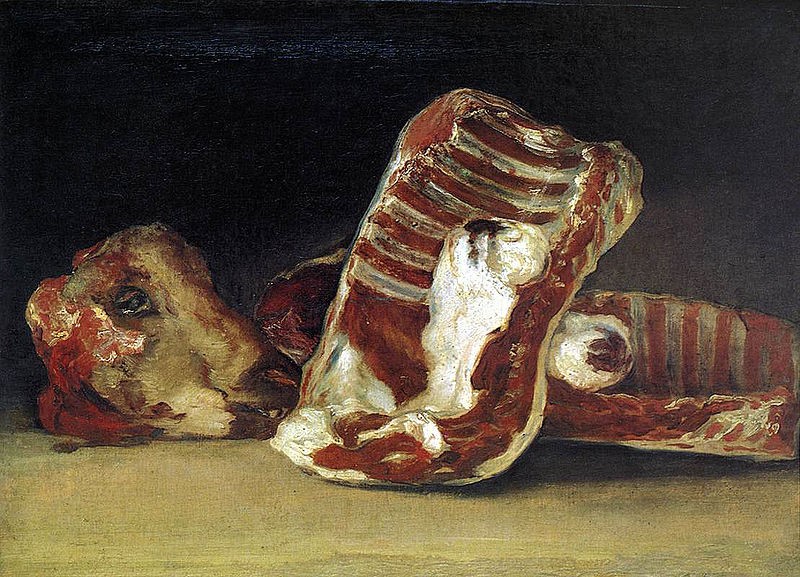
Shylock’s Pawn: Still Life With Sheep’s Head, Francisco de Goya, 1808-12
Little wonder that Shakespeare portrayed the cunning Jew as Shylock, who demanded a “pound of meat” as pawn for lending money to the Christian Antonio, a rich Venetian shipping merchant. This bloody pawn exposed the joy of the playwrite with anti-religious taunts. It inspired his notion of almost bukolic-predatory visualizations of debt. Jews among themselves would generate mutual trust without such visible proof as the historian Heinrich Graetz famously observed, for they “hear their God.” Shakespeare was knowledgeable enough to expose the threadbare Christian Renaissance morale. Klee reflected on the Protestant tragedy of the “sacrificium intellectus” with his drawing of the “ex-philosopher.” Protestant anti-intellectualism depraved them of an exquisite humane gift for accommodating the visual gap.
After the defeat of Napoleon the romantic return to the medieval world manifested itself in Neogotics later in Neo-romanticism, archtecture for the “vegetable man,” eventually succeeded in the fin-de-siecle by the floral motives of art nouveau and Jugendstil. Paul Klee’s aesthetic categories such as “ex-cannibals,” “cunctator,” or “ex-philosopher” are fitting very well into this—all of them flashlights at the infirmities of cultural Protestantism. It is no coincidence at all that a gifted Swiss artist would register the decay of Protestantism, which by the end of the 19th century had secretly abandoned animal sacrifice and sided with campaigns against vivisection and also for Rousseau’s “noble sage.” Hereby Protestants betrayed the shared Abrahamic heritage enshrined in the ritualized “deed”: the sharing of guilt with God via animal sacrifice. It is symbolized forever in the biblical burnt offering in Abraham‘s dream which sealed the covenant of circumcision and also the biblical nexus between kosher food and sex (Genesis 15:12-21). From those sincere foundations of monotheism the West had already departed in the Renaissance eventually replacing the family with the nation state and as a result gradually descending into shame culture.
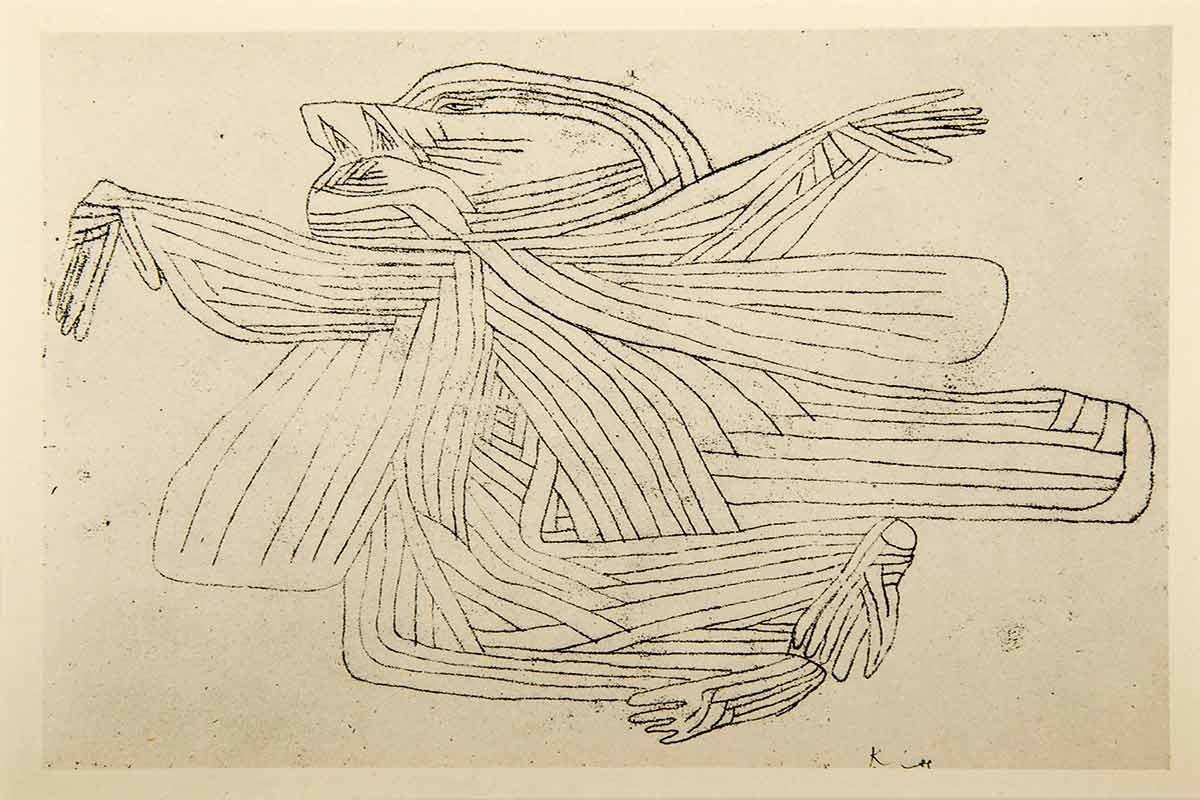
A study in separation and unity: The Creator 2, Paul Klee, 1934
What became of the Abrahamic ritual of animal sacrifice, the ritual of the Temple period? The Jews sanctify rituals of “separation” as the principle of “setting apart”: food, sex, and the holy, which for their lifetime enables Jews to sublimate their physical impulses. We recognise his concern with “intentions” in titles chosen by Klee in a series presenting traditional concepts such as the “cunctator.” His drawing titled “The Creator” of 1934 for instance is made up of parallel white lines eventually coalescing in the divine mouth of what looks like a fat bird. Klee‘s genius invents “divine pin stripes” in order to making visible the creative principle of sanctifying through separation of “setting apart.” Protestantism would later inverse this civilizational breakthrough by reconciling sin and sinner. By internalizing Christ they would be narrowing the unification with the divine to a sentimental act of oral ingestion. It blotted out the sanctifying role of “setting apart” which is why liberals have finally come to celebrate the exact opposite of Jewish separation: global inclusion based on diversity. What is at stake here is the transformation of tangible space into intangible time which is the secret of sublimation and opens the gates to transcendence, spiritual unity with the divine affirming the vertical in authority.
The opposite is flat diversity and inclusion, giving the license for the dissolution of all “forms,” be it sexual license or tearing down borders, initiated by Ronald Reagan to be sure, yet ending in endless migration and the gentile emulation of the “eternally wandering Jew” of old, now tossed against the Jewish nation state. The liberal taboo of limits and borders is the fundamental denouement of separation and unity, leaving us with the choice between two antagonistic Western concepts that are driving today’s culture wars: Greek static mix against Jewish dynamic separation. The Hebrew word Bereshit with its twin meanings of “separation” and “beginning” binds the biblical text of the Abrahamic covenant on circumcision with the account of the creation of the world, the beginning of Genesis. It is to be read as the inauguration of spiritual authority, the fabric of guilt culture. The opposite of sanctifying or “bereshit” is obvisouly “mixing everything” except for excluding the Greek slaves, the nasty stain on Hellenist shame culture. Not for nothing would “fragmentation” or “falling apart,”, a subcategory of “separation,” emerge as the aesthetic signature for Klee’s analytical bent. The polytheist Greeks were incabable of banning cannibalism from their aesthetic imagination. By contrast, in Judaism this kind of sensibility seems to be catered for with mitzvot regarding the strict separation between dairy products and meat. It essentially corresponds with the divide of the sexes and the divine separations of heaven and earth, day and night, etc., reflecting the inner and outer perspective of man.
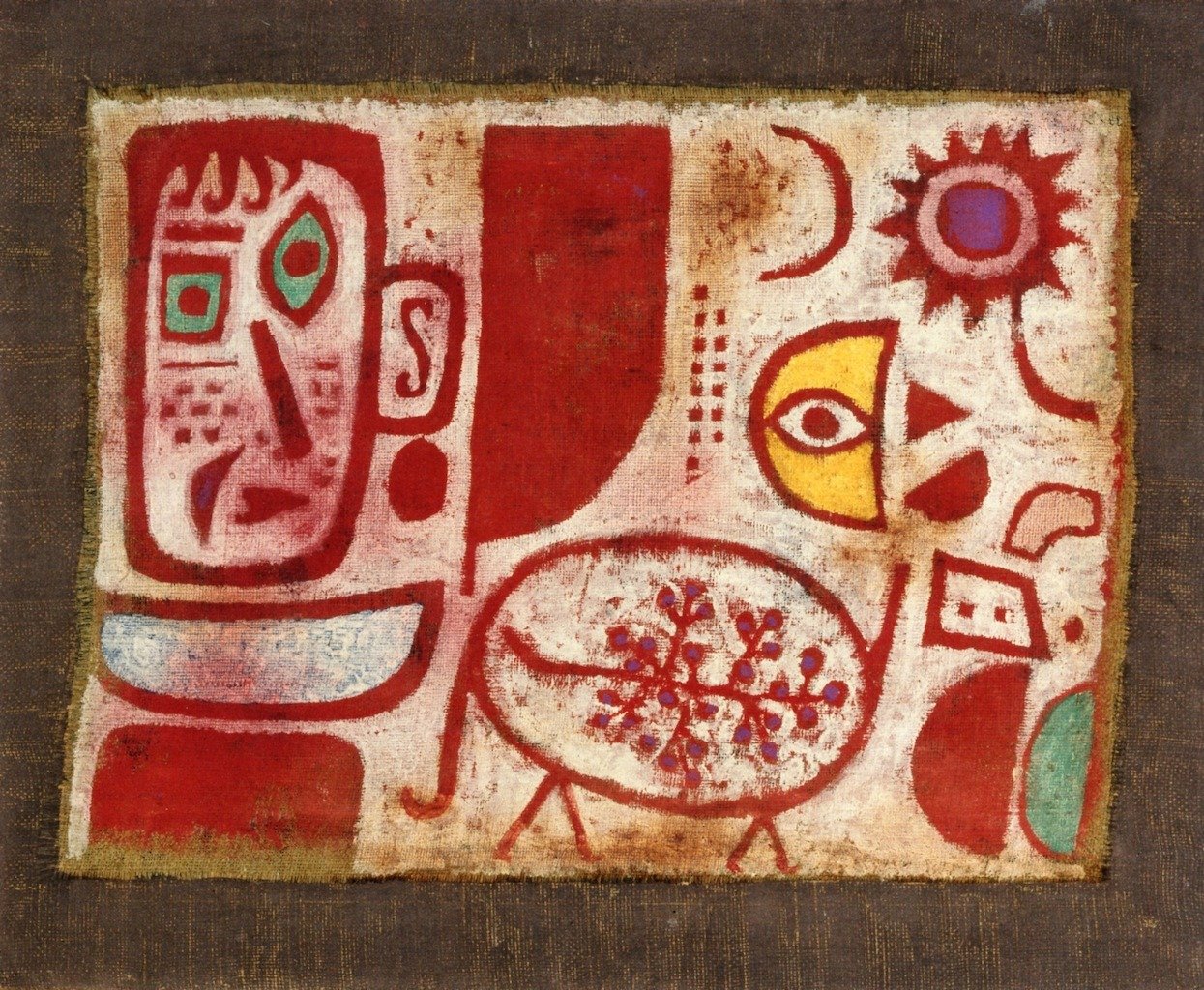
Falling apart in Paul Klee’s Frenzy/Rausch, 1939
This same relation concerns the difference between cognitive and covenental man which had been erased by the internalization of Christ in Protestantism. This had to be compensated for by the romantic “vegetable man” who depends principally on the abnegation of meat rather than on the sublimation of it. This brings us to the heart of the twin biblical institutions of marriage and kosher food, introduced by Abraham.
It rests on conscientuous separations, making thereby great demands on talmudic midrash: recognition and explication of divine law and human works called “mitzvot.” Little wonder that the suppressed longing for meat makes an unwellcome return with the “cannibalistic temptations” of vegetable man in decadent modernity. As we have seen with Goethe the displacement or suppression works for vegetable man as it worked for Christ by blurring the ontological separation of inner and outer perspective. In the same way sexual identity politics emerges from vegetable man by eclipsing the inner self. Both combined wrought the de-sublimation of food and sex that is today going hand in hand. In other words veganism is the complement of genderism; both keep ruining the concept of sublimation. Which brings us back to Klee, namely his drawing of “Ex-cannibals” in which we can see Freud at work. We might say: through the surplus pair of eyes in the drawing the “swallowed” Christ is staring at us. Since the Renaissance only one “divine eye” was on display on banking buildings, symbolically watching over the money exchanges.
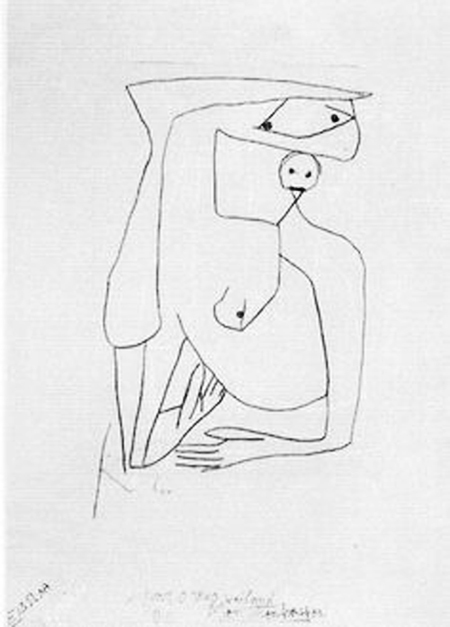
Ex-cannibals, Paul Klee, 1940.
Protestantism internalized the divine eye as a mundane application of divine providence: as a result two pairs of eyes used to watch over all Swiss assets, which was once deemed the Protestant capital of “discrete finance.” Organic “internalized” Christ would in the process of the Reformation determine all other Protestant categories which eventually turned the human conscience into a mere “passion,” driving the mean banker and the vegan alike.
The drawings of Paul Klee can be read as illustration of a process shared by the great Reformators Zwingli and Calvin. Protestant symbolic cannibalism was made visible by Klee with his concept of “double embodiment,” answering to a second Hellenization of Christ. Two philosophers of the last century—not exactly like-minded though—admired Klee for his genius of visualizing the ineffable: Walter Benjamin and Martin Heidegger. It would make all the difference between hyperboreic Occidental and authentic Oriental monotheism. Judaism and Islam kept animal sacrifice and kosher (halal) food as the essential ritual of liberating the human mind by sublimating animal impulses as a matter of cumbersome daily exercise.
Western Christianity reverted this sublimation of animal impulses into an organic “cannibalistic symbolism:” the single weekly act of the “Last Supper” which went on to inspire the romatic organic movement as well as veganism – both regressions from monotheism. It would appear that Islam, Eastern Orthodoxy and, less firmly, Catholicism have preserved the Jewish sublimation of cannibalism, but not Protestants. Large parts of Western Christianity reverted to anti-intellectualism and sentimental piety sustained by organic rituals. To this day this deformation creates tensions not only in Western societies with calls for ending allegedly “cruel treatment” of animals in the kosher or halal food business. The most conspicious group of symbolic cannibalists are liberal addicts, consumers, who resemble “vegetables” in that they are dependant on repetitious stimuli just like plants.
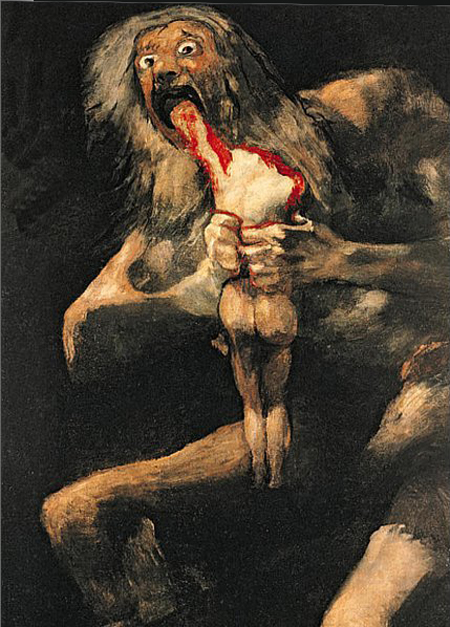
Saturn Devouring his Son, Francisco de Goya, 1823
Man’s addiction is akin to a “vegetable state” because it lacks free will. Plants became popular while German quietist romantics kept their head down during the reactionary post-Napoleonic times of Biedermeier. Romantic vegetable man remained popular on the Continent even after the revolts of 1830s and 1848 came to nothing precisely because it lacked “testicles and free will” turning youth into romantic dreamers. Of course this was pre-mediated by a long tradition of submission formed by Luther, Spinoza, and Leibniz. Repetitious stimuli of vegetable man would go mainstream in the addictive personality subscribing to Nietzsche’s vegetable laws of “eternal recurrence of the same.” The romantics fully embraced the vegetable philosophy of surrender and self-hatred, sacrificing free choice to natural determinism through firm rootedness in the ground. Romantics transferred the notion of roots to racism and genderism adding the ideal of limitlessness and craving for infinitude. This is the stuff of addiction with people who never come to grips with their own nature. We have to remind ourselves that the Great Flood was meant as punishment for the failed civilization of Adam & Eve, which ended in Sodom, the failure being blamed on the fact that their animal instincts had been ill served by archaic veganism.
That is why in the post-diluvian world of Noah would be somehow relaxed by conceding the consumption of meat, subject to the ethical code of Noah regulating ethical conduct with regard to animal prey. I gather all this comes to life in Klee‘s drawing “Ex-Cannibals.” For it shows two pairs of eyes with one eye seen in profile indicating that different perspectives of humans are a post-cannibalistic accomplishment. For this insight it is essential to realize that the Greek “visual paradigm” does not cover the whole of reality because we cannot see what is behind us. Athens and Jerusalem came up with different solutions for this anthropological handicap: the Greeks addressed this existential insecurity with artificial embodiments—assembling endless statues around them as representations of their protective Gods—yet they also allowed the “vis a tergo” (homosexuality) to florish. By contrast Judaism filled the blind spot of vision by imposing their auditive paradigm on reality for hearing is panoramic and has no blind spot.
Greek polytheism failed because their many halfgods are zentrifugal and confuse us. Jewish monotheism is superior because it has a centripetal pull to the family and genuinely domesticates anxiety by listening to one external God who unifies all perspectives of reality. This corresponds with Klee who was keen to “visualize” different “ontological” perspectives exposing the limitations of our human disposition. After all, the Torah gives two versions of light in its twin accounts on divine creation in Genesis, one diffuse grey light pre-existant like the Torah, and a second brighter light radiating from the sun, reflected by other planets, which God created on the fourth day. In this way cannibalism seems to depend on an exclusively visual reality, where appetites are not counter-balanced by the voice of conscience. This is my understanding of Klee‘s intension emerging in several of his drawings. They demonstrate his utter concern with the deficits of the visible paradigm. A good example are the “Two Monkeys,” embodiments of unfettered appetite molesting humans from behind, exposing delicately the blind rear spot of the visible paradigm.
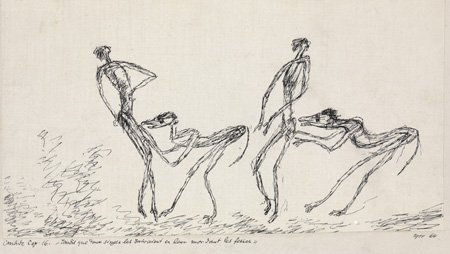
Two Monkeys, Paul Klee (for Voltaire’s Candide, Chapter 16), 1911
Looking at this from a different angle we can observe the eye runs ahead of us and, left to its own means, might easily lead us astray. If unleashed—the Orient keeps speaking of the “evil eye”—the visual sense alone subjects us to a warped reality. Interestingly, Klee gains great “actuality” at a time when sexual intercourse even by heterosexuals is shown lately in the media more in its anal variety, which brings us back to the significance of Judaism. As it is centered on an “invisible God” conceived within the auditive paradigm it is corroborated by the monotheist ban on images (second commandment) also alive in Islam and to a lesser degree in Eastern Orthodoxy with constrained visibility in holy Icons. Now, in the biblical story of Abraham being tested by God with sacrificing his only son Isaac, known as the Akedah, Judaism abandoned human sacrifice for good and replaced it with the burnt offering of a ram, at a time when all over the Roman Empire small children, mostly boys, had been regularly killed as rivals to the reigning patriarchs. This collective trauma would be atoned with the symbolic sacrifice of Christ in an act of culturally appropriating Hellenism. Yet the price for this was the transgression of the monotheist image ban with the “incarnation of the Messiah,” which remains alien to Rabbinic Judaism. While the Jewish Talmud mitigated abundant use of the death penality in the Torah by laborious casuistic midrashic work, Pauline Christianity created Christ as universal Redeemer.
The important point is that divine embodiment of Christ meant first of all to atone for the secular sin of mass infanticide and secondly fill up the incomplete visual paradigm with Hellenism. After all, Greek polytheism and tragedy had always depended on panoramic visible gods because it answered to abundant demands for (metapysical) tangible proofs of divine assistance. By contrast, Judaism is wholly occupied with transcendence and offers no such thing. Hence, transcendent truth claims in Judaism are of an incorruptible quality. They are embedded in the invisible structural features of the Hebrew tongue which alone allows Judaism to survive without idols and images. Hebrew itself protects the religious imagination of the faithful, keeping it wholly occupied with transcendent intangibles, i.e. sanctified words. Klee’s ink pen drawings make sparse use of lines, displaying an almost Jewish sensibility towards idolatry. Many of these drawings are dwelling on the analytical property of the eye, presenting human beings by dismantling the body into all its parts and members. Only the carefully drafted title is often hinting at a synthesis, ennobling the word over the image.
.jpg)
Fame, Paul Klee, 1939
Only language in the service of the auditive paradigm excells in synthesis and creates a transcendent order of meaning, by making sense of the world for ourselves. Conversely, Klee presents envy as the the sin of shunning separations and conjuring up conspirational hallucinations or zero-sum thinking. His large yellow canvas from 1939 is called “Fame” and presents two white figures almost “mangling” each other. Presented on a deep yellow background it gives us the idea of fame grounded in envy alone. This brings us back to the ex-Cannibalist displayed above, a figure dominated by disconcerting staring eyes, a pure and simple image wrapped up by Klee’s perplexing title. The title “ex” exposes the fragility of the advance of our civilization in getting past our cannibalist drive. However, Klee mocks it by framing it in volatile and situational terms like “ex-smoker” who is liable all too soon to revert back into his old habit; for him, setting apart of just one cigarette is tantalizing. But a particularist reading should turn to the Swiss Reformation that weaned people off of daily routines and opened up the gates of addiction. I always wondered why there are no alcoholics in Italy let alone the larger Mediterranean. It has to do with Catholicism and Islam both of which stayed clear from the Protestant neurosis over indulgences and charitable deeds.
Conversely, Calvinism developed the frugal spirit that once stood for mean Switzerland, because it shunned charitable deeds and intellect as hypocrisy. But Protestantism ended with depreciating the word and internalizing the image. All this is perfectly expressed by the “ex-philosopher” with two flat pairs of eyes in one body, to whom the idea of different perspectives does not occur. This expresses an essentially self-contained Protestantism thanks to a fully internalized Chris: “Jesus in the heart.” It became the model for the self-centered and self-absorbed modern liberal, who has only fleeting or distant regard for the suffering of man and the common good. In other words: Klee’s fragmented figures represent our atomistic society loosely connected by deceptive images, loath of the sublime nexus offered by words. It is for this reason that his synthetic titles often appear as acerbic comments on modernity which he experienced during his sojourn in Weimar and Dessau where he taught art students at the Bauhaus. Klee rendered Protestant anti-intellectualism as an archaic, two-dimensional Egyptian “relief,” which famously predated the biblical Exodus. So much for his drawing “Ex-philosopher” of 1940. The exhibition in Bern leaves the impression that Klee was a gifted draftsman and to a lesser degree a painter. More drawings in the two-dimensional renditions of relief belong to his cycle called “eidola” depriving drawings of the deep space or third dimension. Another cycle was inspired by Voltaire, whom Klee seems to have adored. Klee would tear apart bourgeois “window dressing” after WW I exposing in his drawings the abundant Western shame culture, namely in his Candide-series. This was a succinct commentary on Voltaire’s enlightened confessions, which in Klee’s drawing take on rather a “dialectic of evil” – long before T.W. Adorno’s essay on the “Dialectics of the Enlightement” of 1940. One example for this is Candide Chapter 22: “The light will kill her” of 1911. The killing light points again to our vulnerability by a “totalitarian” visible paradigm, with nowhere to hide, denying us the inner perspective. Sentimental vegetable man wants us always to forget this very human handicap.
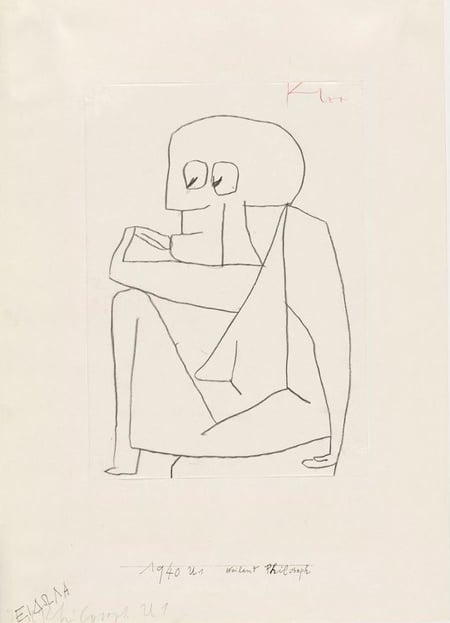
Erstwhile Philosopher, Paul Klee, 1940
All this would countinue to our day in the whole grain-vegan lifes-style as the paradigm for one-dimensional man, relying solely as he does on “image personalities,” void of any meaning yet fully commercialized in “conspicuous consumption.” These are the same “fragile personalities” which get offended by microaggressions because they have disabused themselves of uncomfortable perspectives and opposing moral outlooks. Together with fast food the permanent exposure to images incessantly actualizes the (Spinozan-Leibnizian) extremely reductionist modern “perceptive-appetititive” pan-sensualist model where touch, gaze, and desire are melted together. This is suggested by the Klee-drawing “chain of events” as a self-fulfilling nigthmare of immmediate safisfaction, showing a one-stick figure with a wide cloth next to one naked. All one-stick figures belong to the “Candide”-series. An equally provocative example shows two figures lying down and embracing each other. It is titled “egalitarian examination, sensa cogli” (Italian for “testicles”) and exposing the shallowness of sexual education. Most instructive from the Eidula series is “Ex-Cannibals,” created toward the end of his life, which plays with the visual reductionism in metaphors like “eating” each other “with ones eyes” as the saying goes.
To me the series “eidola” shows the relentless “analytical” appetites of vision: the eye is given to cutting things apart to see what’s in them, while ear and speech using words in order to synthesize things together. Many of Klee’s drawings are either analytical or synthetical. Yet public images of nakedness or undressing are on the rise. This is supposed to set off “chains of events” under the dictate of appetites. Hence trash attire and ragged clothing expose flashes of bare skin and are eliciting impulses of the flesh while at the same time antagonizing our conscience. Our enlightended modernity relentlessly exposes us to this game turning us into slaves of the flesh and taking away spiritual freedom.
Hence enligtening our biology collapses the last hold of our self control and delivers us to natural compulsion, the opposite of freedom. This was in a sense what Goya keeps telling us: the “sleep of reason produces monsters.” But active reason does might wreak even more havock. The last of his slew of “black paintings” was about cannibalistic infanticide (Saturn eating his son). Like many others of his “murals” Goya painted it on the wall of his own farm house in Madrid at the end of his life. The murals were committed to his prophetic vision of barbaric Rousseauism, exposing the noble savage, today impersonated by green politics. No doubt, Goya had a morbid interest in cannibalism and depicts romantic “vegetable man” as potential cannibal, anticipating Green humanity in the Hobbesian state of nature.
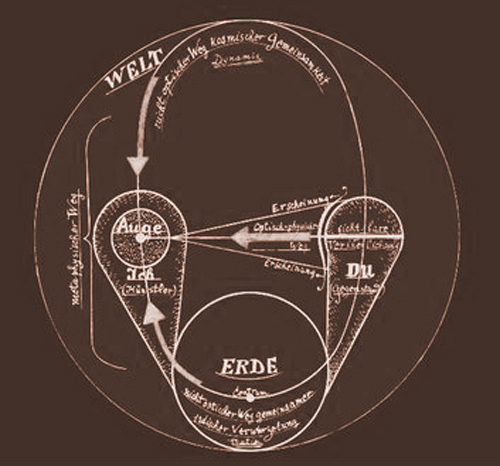
Klee’s creative concept
To sum it all up: Upon the destruction of the Temple in Jerusalem, Judaism had to leave animal sacrifices and embrace self-sacrifice (of the will) in synagogue. Assisted by Rabbinic Judaism this meant stepping up from outward shame to inward guilt and with that ascending from the visible to the auditive paradigm. Yet Christianity reverted half way back toward symbolic human sacrifrice or the outward visible concept of incarnation by creating the somewhat “insincere” sacrifice by proxy which in our day has been emulted by the liberal habit of sacrificing adversaries as the “other.” Vegetarians answered with their complete de-incarnation as vegans. Now, what will come of this rescinding from animal sacrifice which returns us somehow to the antidiluvian human condition? Veganism understood in the historical context externalizes Rabbinic self-sacrifice again, yet losing on the way any spiritual reward of Jewish ritual. This turns veganism into a disease and suffering by proxy, just like Christ. These facts Klee seems to have taken to heart. He died prematurely of sclerodemia, a disease of the connective tissue, at the age of only fifty one. Like Klee, if, for different reasons, Judaism has since thousands of years disapproved of any sacrifice or atonement by proxy.
___________________________________
Dr. Friedrich Hansen is a physician and writer. He has researched Islamic Enlightenment in Jerusalem and has networked on behalf of the Maimonides Prize. Previous journalistic and academic historical work in Germany, Britain and Australia. He is currently working in Germany and Australia.
Read more by Friedrich Hansen here.
Please help support New English Review here.
- Like
- Digg
- Del
- Tumblr
- VKontakte
- Buffer
- Love This
- Odnoklassniki
- Meneame
- Blogger
- Amazon
- Yahoo Mail
- Gmail
- AOL
- Newsvine
- HackerNews
- Evernote
- MySpace
- Mail.ru
- Viadeo
- Line
- Comments
- Yummly
- SMS
- Viber
- Telegram
- Subscribe
- Skype
- Facebook Messenger
- Kakao
- LiveJournal
- Yammer
- Edgar
- Fintel
- Mix
- Instapaper
- Copy Link









